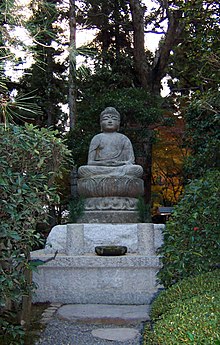Ryōan-ji


Ryōan-ji ( Japanese 龍安寺 , Temple of come to rest dragon " ) is a 1499 founded Zen - Temple in the northwest of the Japanese city of Kyoto in whose district Ukyō .
It was built in 1450 by Hosokawa Katsumoto , a senior civil servant of the Muromachi period , on land that originally served as a country estate for the Fujiwara family. Since 1994 it belongs along with other sites on UNESCO - World Heritage Historic Kyoto (Kyoto, Uji and Otsu Cities) . The temple belongs to the largest school of Rinzai Zen with the mother temple Myōshin-ji .
The main attraction of the temple is the most famous zen garden in Japan, the Hojo-Teien in the Kare-san-sui style from the middle of the 15th century . The garden consists of an area (25 by 10 meters) made of fine, fair gravel with 15 seemingly randomly placed stones in 5 mossy groups. All 15 stones are not visible from any angle. The southern and western sides of the garden are lined with a reddish wall, over which the view of the trees and bushes of the accessible garden falls. On the northern side is the temple building with the terrace from which one overlooks the rock garden. The surrounding wall is plastered with oil-soaked clay. Over the centuries, the oil has leaked, leaving behind the characteristic pattern.
The temple complex also includes a large pond, which goes back to the very first temple foundation at this point in the 10th century. In the middle of the pond is a small, walkable island with a shrine dedicated to the deity Benzaiten .
Individual evidence
- ↑ Morigami Shōyō ( 森 神 逍遥 ): 『侘 び 然 び 幽 玄 の こ こ ろ』 ─ 西洋 哲学 を 超 え る 上位 意識 ─ ("Wabi sabi yūgen no kokoro: seiyō, ISBN 2015, ISBN 2015 o koeru jōi ishiki no h.") 978-4-434-20142-4
Web links
- Temple website - Japanese and English
- Kyōto Prefecture Information Center - English
- Information offered by the city of Kyoto - English
Coordinates: 35 ° 2 '4.3 " N , 135 ° 43' 5.5" E